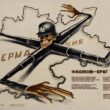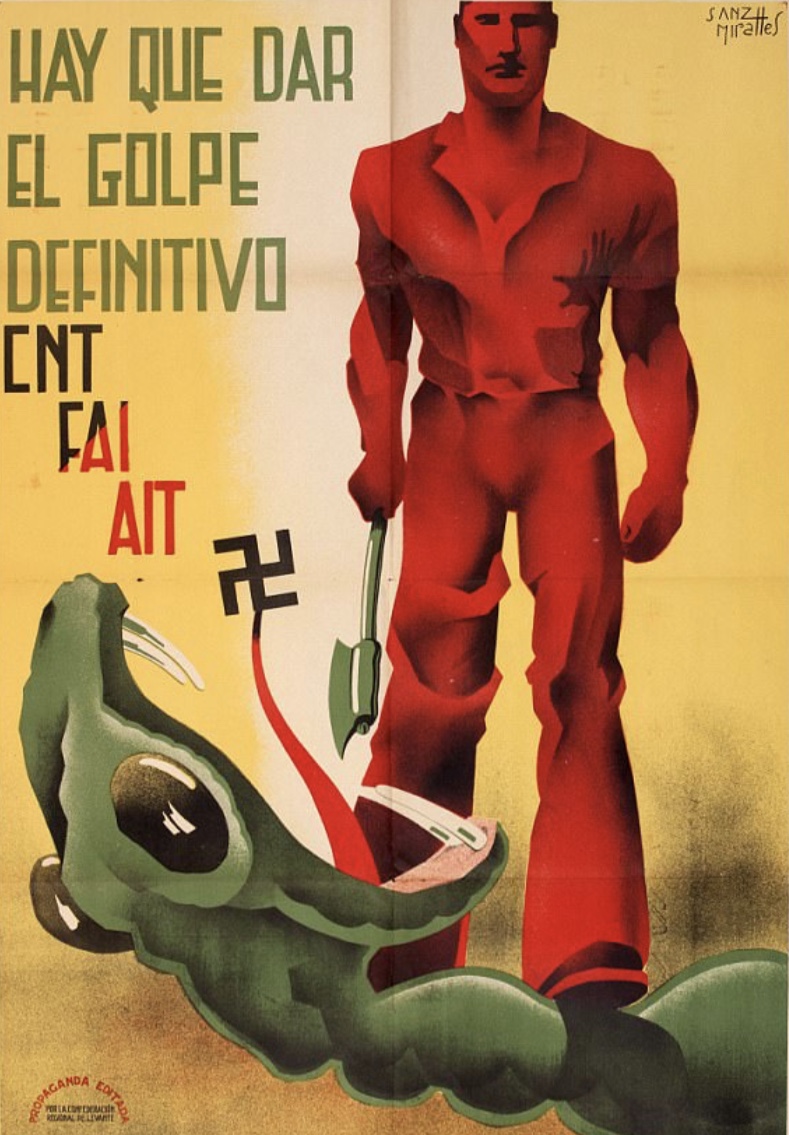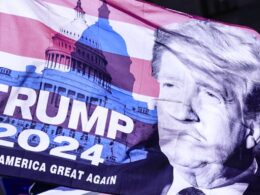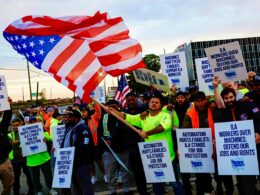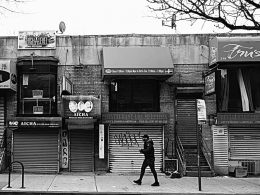It’s crucial for communists who live in the USA’s rural areas to realize that they can’t wage an equivalent of Mao’s People’s War from their present locations. Trying to do so would be completely counterproductive, no matter how big capitalism’s contradictions become. This is because rural America, from a strategic military standpoint, is dominated by the reactionaries. But this option’s lack of viability merely means we need to search for an option that is viable.
The social forces with the greatest stake in defending the state
Even though there’s a disproportionate amount of poverty in rural America, with the fascist movement led by and concentrated within the upper income strata, this rural minority has the arms and organization to be able sweep across the country’s rural section should civil war arise. When class conflict intensifies, these militias will receive support from law enforcement in their effort to purge the countryside of those who threaten capital.
We in the rural areas should do all we can to organize the working class in our communities. But when this escalation comes, we’ll need to use the strength we’ve gained from this initial work to redirect our efforts in a strategically smart fashion. The great strength of capital within a massive settler-colonial country like the USA, where one state has grabbed up half a continent, is that this lets the reactionary element hold control over the vast majority of territory. The minority of whites who own land, particularly those among them with comfortable incomes, have some of the greatest material stake in defending the system, aside from the oligarchs. Naturally they’ve gravitated towards participating in fascism, capital’s fighting wing. This means that the strategic advantage of the revolutionaries during the moment of class confrontation lies within the urban areas.
It’s in the metropolitan centers, specifically the economically deprived neighborhoods surrounding the wealthy business hubs, that the mass revolts will be strongest and most formidable. This is a basic principle of social unrest. Especially in a place like the United States, where the poorest and most discriminated against racial groups have been concentrated within the cities. The exception in this regard is the indigenous people, who unlike the African diaspora are concentrated within rural reservations. Natives have the double disadvantage of being an oppressed internal colony of the U.S. empire, and of having had their communities shoved into spaces that will be vulnerable to the violent fascist sweep. But they have hope in an African-Native liberation alliance, which has been getting built for generations despite the contradictions colonialism has created among these groups. With the help of the other groups who’ve been subjected to violence due to the imperial structure, such as brown people and Asians, as well as the whites who’ve gained interracial solidarity due to their also being exploited by capitalism, this alliance will defeat the empire from within.
Such is the dual nature of the prospects for revolution in the imperial center: at the same time that our social reality creates obstacles towards liberation in certain ways, it creates hopeful factors in other ways. The rural section is especially vulnerable to fascism for the same reason the urban section is especially vulnerable to revolution: because the U.S. empire’s formation has shaped class and racial demographics in ways which place the prosperous and deprived groups in quite different locations. The advantage this gives us is that the cities are the weak points within capital, most immediately able to be liberated from bourgeois dictatorship. The disadvantage it gives us, and that we’ll need to overcome through careful tactics, is that an attempt at revolution centered in the cities involves certain obstacles. Some of which are particular to modern urban America, and the mechanisms for repression that the ruling class has put in place within the metropolitan areas.
The necessary challenge of waging an urban-centered revolution
One of these obstacles is the dissent-hostile design of many of today’s cities. As assessed by Phil Neel in his book Hinterland, cities like Ferguson contrast with cities like New York in that their layouts are still filled with spacious streets, rather than the narrow and densely lit urban corridors that are built to help police counter unrest. Neel describes the 2014 Michael Brown protests as especially hard to suppress due to this beneficial environment they took place within:
When Jesse Jackson’s motorcade showed up in front of the McDonald’s on Florissant, he was quickly confronted by a crowd of protestors yelling for him to “go home.” The soft counterinsurgency seemed just as inept as the Ferguson police, and only a few days after the staged hugs, the governor was declaring a state of emergency. Deployment of the National Guard followed, dropping any pretense of gentle recuperation. The other features that extended the riots in Ferguson were largely artifacts of the area’s own affluent past: the lack of surveillance, its decentralization, the ease with which rioters could move between street, forest, and fenced-in yard. Quite unlike the narrow street-and-alley geography of the urban riot, this suburban unrest had an enormous amount of space within which to operate—the main constraint was not the police or the physical obstruction of traffic and buildings, but instead the long, flat distance between decentralized targets. The police tried to use this space to their advantage, forcing the protestors to march in an unending circle up and down the suburban strip, rather than kettling them or otherwise hindering their motion. But it was difficult truly to control such a large territory, and when the National Guard arrived, they were largely seen protecting big-box stores or other presumed targets, rather than attempting to patrol the entire area.
The difference between these kinds of revolts against state violence from this last decade, and the revolts against state violence we’ll see tomorrow, is that the next uprisings will take on more intense forms. They may include an armed insurgency against law enforcement, expanding upon the sporadic incidents in recent years where anti-police political actors have used firearms. From a sociological perspective, the intensifying nature of the oppression the internal colonies face—in which their poverty deepens and the police which terrorize them grow ever more militarized—is leading up to such a guerrilla rebellion. The question is whether a workers party manages to be built that can guide this organic, spontaneous outrage in a way which leads to the state’s defeat.
Given the ways in which certain U.S. cities have been engineered to better absorb unrest, the revolutionaries won’t necessarily liberate all of them at once. But by maneuvering correctly, and identifying capital’s points of weakness, they’ll be able to use places like Ferguson to gain leverage. So much leverage that the rest of the continent then gets freed from the grip of fascism.
This entails doing the equivalent of what Russia has done in Ukraine: conserve its own resources so that it can wear down the resources of its opponent, getting the opponent to expend great amounts of arms that can’t be sufficiently replaced. Russia hasn’t had to gain the majority of Ukraine’s territory to accomplish this. It’s only had to gain control over the places strategically important to it, those being the localities in the eastern region. Because when Russia gained this region, Kiev’s fascist regime would stop at nothing to try to regain it, however futile this goal was. And NATO wouldn’t stop backing Kiev in this absurd endeavor, because NATO’s goal is to drag out the war long enough that it destabilizes Russia in the process. Kiev and NATO miscalculated on how much they could handle, as well as on how much Russia could handle. Now Washington, not Moscow, is the side that’s been weakened to a degree which will prove fatal.
To be able to use cities like Ferguson for this war of attrition purpose, the revolutionaries will need to ensure that these cities can sustain millions of residents while the surrounding areas are controlled by enemies. And that the liberation projects don’t come undone due to internal failures, like CHAZ did. This means starting or contributing to an urban gardening project if you live in a city, and getting experience with gardening if you presently live in a rural place, so we can better feed the people during the revolution’s chaotic phase. This means enforcing strict discipline and diligent studying within our parties so that as we physically train, we aren’t brought down by adventurist foolishness. This means building alliances with the states that are challenging U.S. imperialism so we’ll have powerful friends with resources to turn to, and learn from how these states have fought off imperialism.
This means adopting the stance that the gangs can’t be avenues for revolution, at least not as long as they remain gangs; when the Young Lords decided to become revolutionaries, they by necessity transitioned away from functioning as a gang. And this is the best case scenario for a gang. At worst, gangs can act as tools for intelligence infiltration within disenfranchised communities, letting in feds simply because feds can be good at drug running. To unite the proletariat with the lumpen, we don’t need to fetishize the gangs. We need to provide these communities that have been forced to the economy’s margins with material aid and defense programs, providing an alternative to the desperate resort of the oppressed which is gangsterism.
The social elements with the greatest stake in defeating the state
Ultimately, the goal is to proletarianize everybody who’s been shut out of the proletariat by capital’s cruel mechanisms, getting everyone access to jobs with good pay and workplaces the workers control.
Such is the pitch that’s capable of uniting everyone in the imperial center who doesn’t have a primary material stake in maintaining imperialism: with workers revolution, if you’re lumpen you’ll get a safe job with dignity, and if you’re already working class, you’ll gain true democratic agency. In this stage of the revolution, the goal is to expand the size of the proletariat, and lift all among the proletariat up to the educational level of a trained cadre member. This involves not just reading the theory, but carrying out the social practice. By establishing routines of productive activities, from fitness and arms training to garden work to proletarian education, we’re capable of giving the people constructive outlets the system has cut them off from. Through this, we can begin proletarianizing those who’ve been excluded from the proletariat before we’ve attained state power, and become capable of providing actual jobs.
Capital’s biggest weakness is that in its present stage of collapse and contraction, it’s all the time creating more people who experience this alienation from the ruling institutions. If these institutions aren’t providing for the needs of the people, what incentive do the people have to stay loyal to the system? Posing this question is how we’ll win to our cause many people within the demographics which have great revolutionary potential, but which aren’t yet necessarily attached to revolutionary politics. Groups like the felons and the veterans.
These two groups in particular represent great hope for our cause, because they share the trait of being ground through a machine that’s shown it cares nothing for them. Because the felons have overwhelmingly experienced incarceration due to a rotten criminal justice system designed to punish the poor, and experience economic and political disenfranchisement outside of prison, they’ll have the least to lose if given the opportunity to fight the state. And the veterans are historically crucial for the success of communist revolutions, which have frequently involved recruiting disillusioned military members. In America, they especially have revolutionary potential, as the poverty draft has made the military’s low-level ranks disproportionately working class. In their own ways, the veterans are also victimized by the system that handles them, often undergoing trauma and then not being able to get help from a failed Veterans Administration.
It’s no surprise that the veteran anti-war movement, as well as the criminal justice reform movement, represent some of the most revolutionary forces in grassroots politics. Veterans and felons are both frequently traumatized by the imperialist power structure in different ways, with veterans commonly experiencing the trauma of war while felons commonly grow up in violent neighborhoods which give their residents mass PTSD. The empire has manufactured war both abroad and at home, giving rise to the domestic forces that have the most incentive to bring down the empire.
We will bring these forces into the workers revolution, and we will carry this revolution to its completion. The core motivating factor for someone to become a Marxist is when they witness, or are subjected to, injustices within the social system they inhabit. Because capital is perpetually expanding the amount of people who’ve been forced to absorb this knowledge, whether through worker exploitation, cruel carceral policies, or destructive militarism, the number of those willing to participate in workers revolution constantly grows. They’re waiting to be given the opportunity to tear down this social order that’s done them so wrong.
—————————————————————————
If you appreciate my work, I hope you become a one-time or regular donor to my Patreon account. Like most of us, I’m feeling the economic pinch during late-stage capitalism, and I need money to keep fighting for a new system that works for all of us. Go to my Patreon here.



